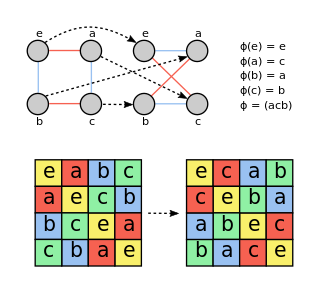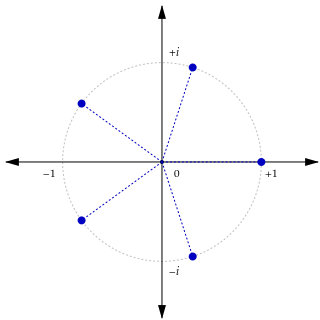
In mathematics, an automorphism is an isomorphism from a mathematical object to itself. It is, in some sense, a symmetry of the object, and a way of mapping the object to itself while preserving all of its structure. The set of all automorphisms of an object forms a group, called the automorphism group. It is, loosely speaking, the symmetry group of the object.

In mathematics, an abelian group, also called a commutative group, is a group in which the result of applying the group operation to two group elements does not depend on the order in which they are written. That is, the group operation is commutative. With addition as an operation, the integers and the real numbers form abelian groups, and the concept of an abelian group may be viewed as a generalization of these examples. Abelian groups are named after early 19th century mathematician Niels Henrik Abel.
In abstract algebra, the center of a group G is the set of elements that commute with every element of G. It is denoted Z(G), from German Zentrum, meaning center. In set-builder notation,
In mathematics, particularly in the area of abstract algebra known as group theory, a characteristic subgroup is a subgroup that is mapped to itself by every automorphism of the parent group. Because every conjugation map is an inner automorphism, every characteristic subgroup is normal; though the converse is not guaranteed. Examples of characteristic subgroups include the commutator subgroup and the center of a group.

In mathematics, an isomorphism is a structure-preserving mapping between two structures of the same type that can be reversed by an inverse mapping. Two mathematical structures are isomorphic if an isomorphism exists between them. The word isomorphism is derived from the Ancient Greek: ἴσοςisos "equal", and μορφήmorphe "form" or "shape".

In mathematics, specifically group theory, given a prime number p, a p-group is a group in which the order of every element is a power of p. That is, for each element g of a p-group G, there exists a nonnegative integer n such that the product of pn copies of g, and not fewer, is equal to the identity element. The orders of different elements may be different powers of p.
In abstract algebra an inner automorphism is an automorphism of a group, ring, or algebra given by the conjugation action of a fixed element, called the conjugating element. They can be realized via simple operations from within the group itself, hence the adjective "inner". These inner automorphisms form a subgroup of the automorphism group, and the quotient of the automorphism group by this subgroup is defined as the outer automorphism group.

In mathematics, particularly in complex analysis, a Riemann surface is a one-dimensional complex manifold.

A group is a set together with an associative operation that admits an identity element and such that there exists an inverse for every element.

In the mathematical field of Lie theory, a Dynkin diagram, named for Eugene Dynkin, is a type of graph with some edges doubled or tripled. Dynkin diagrams arise in the classification of semisimple Lie algebras over algebraically closed fields, in the classification of Weyl groups and other finite reflection groups, and in other contexts. Various properties of the Dynkin diagram correspond to important features of the associated Lie algebra.

In mathematics, a simple Lie group is a connected non-abelian Lie group G which does not have nontrivial connected normal subgroups. The list of simple Lie groups can be used to read off the list of simple Lie algebras and Riemannian symmetric spaces.

In mathematics, especially in the group theoretic area of algebra, the projective linear group (also known as the projective general linear group or PGL) is the induced action of the general linear group of a vector space V on the associated projective space P(V). Explicitly, the projective linear group is the quotient group
In mathematics, the projective special linear group PSL(2, 7), isomorphic to GL(3, 2), is a finite simple group that has important applications in algebra, geometry, and number theory. It is the automorphism group of the Klein quartic as well as the symmetry group of the Fano plane. With 168 elements, PSL(2, 7) is the smallest nonabelian simple group after the alternating group A5 with 60 elements, isomorphic to PSL(2, 5).

In hyperbolic geometry, the Klein quartic, named after Felix Klein, is a compact Riemann surface of genus 3 with the highest possible order automorphism group for this genus, namely order 168 orientation-preserving automorphisms, and 168 × 2 = 336 automorphisms if orientation may be reversed. As such, the Klein quartic is the Hurwitz surface of lowest possible genus; see Hurwitz's automorphisms theorem. Its (orientation-preserving) automorphism group is isomorphic to PSL(2, 7), the second-smallest non-abelian simple group after the alternating group A5. The quartic was first described in (Klein 1878b).
In mathematics, the outer automorphism group of a group, G, is the quotient, Aut(G) / Inn(G), where Aut(G) is the automorphism group of G and Inn(G) is the subgroup consisting of inner automorphisms. The outer automorphism group is usually denoted Out(G). If Out(G) is trivial and G has a trivial center, then G is said to be complete.
In mathematics, a group G is said to be complete if every automorphism of G is inner, and it is centerless; that is, it has a trivial outer automorphism group and trivial center.
In mathematics, Hurwitz's automorphisms theorem bounds the order of the group of automorphisms, via orientation-preserving conformal mappings, of a compact Riemann surface of genus g > 1, stating that the number of such automorphisms cannot exceed 84(g − 1). A group for which the maximum is achieved is called a Hurwitz group, and the corresponding Riemann surface a Hurwitz surface. Because compact Riemann surfaces are synonymous with non-singular complex projective algebraic curves, a Hurwitz surface can also be called a Hurwitz curve. The theorem is named after Adolf Hurwitz, who proved it in (Hurwitz 1893).
In mathematics, in the realm of group theory, an IA automorphism of a group is an automorphism that acts as identity on the abelianization. The abelianization of a group is its quotient by its commutator subgroup. An IA automorphism is thus an automorphism that sends each coset of the commutator subgroup to itself.
In mathematics, in the realm of group theory, a class automorphism is an automorphism of a group that sends each element to within its conjugacy class. The class automorphisms form a subgroup of the automorphism group. Some facts:

In Riemann surface theory and hyperbolic geometry, a Hurwitz surface, named after Adolf Hurwitz, is a compact Riemann surface with precisely 84(g − 1) automorphisms, where g is the genus of the surface. This number is maximal by virtue of Hurwitz's theorem on automorphisms (Hurwitz 1893). They are also referred to as Hurwitz curves, interpreting them as complex algebraic curves (complex dimension 1 = real dimension 2).






